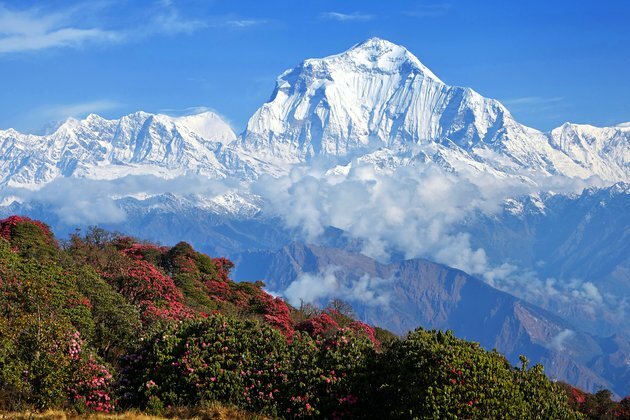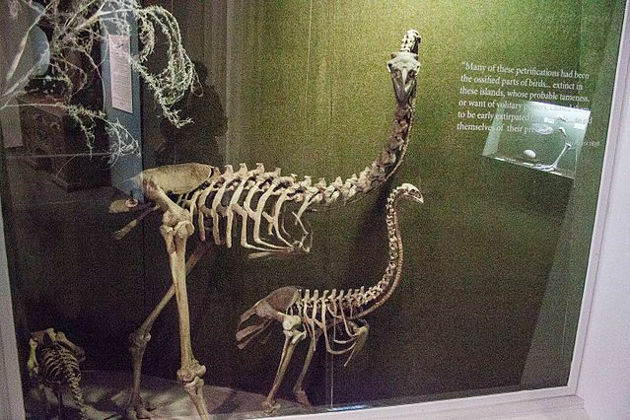How plankton helped create the Earth's mountains 2 billion years ago
The Conversation
03 Dec 2021, 00:11 GMT+10

A world without the great mountain ranges - the Himalayas, the Alps, the Rockies, the Andes - is unimaginable, but they were not always a part of the Earth's geography. Mountains didn't start forming widely until 2 billion years ago, half way through the planet's history. Now our research has revealed how primitive life played a key role in their introduction to the planet.
While the formation of mountains is usually associated with the collision of tectonic plates causing huge slabs of rock to be thrust skywards, our study has shown that this was triggered by an abundance of nutrients in the oceans 2 billion years ago which caused an explosion of planktonic life.
Making mountains
Mountains are not just a beautiful backdrop for recreation, they are essential to the way the world works, through their influence on weather, climate, the distribution of fresh water and the erosion of rock to make cultivable soil.
Before there were mountains, the plate movements that reshape the distribution of oceans and continents only occurred on a limited scale. But the movement of these plates are essential to making mountains. The pressure of one plate pushing against another - typically an ocean plate hitting a continental plate - causes slabs of ocean rock to break off and stack up on top of each other as they are pushed from behind.
Over millions of years the stack of rocks builds up, creating mountains, just as the Himalayas were built from ocean rocks between India and Eurasia, pushed northwards until the ocean disappeared and its remains were left piled high.
We know these mountains came originally from the ocean by the sea fossils found on the Tibetan plateau, thousands of metres above sea level. But piling up huge slabs of rock on such a scale needs serious lubrication, otherwise friction would stop them. That lubricant is carbon, which became part of the ocean rock when dead plankton fell to the ocean floor and became buried.
Plankton have lived in our oceans for over 3 billion years, but 2 billion years ago their numbers exploded when abundant nutrients entered the water. At the time, life was no more complex than their single cells. But the cells became much bigger, and they contained more carbon.
When they died they sank quickly and were buried in mud which created rock with unprecedented amounts of carbon, which was turned into graphite by heat and pressure. Graphite makes a great lubricant. Locks, hinges, gears, wheels and even zips all move more easily with graphite - and so do rocks.
Lubrication
The plentiful graphite that accumulated beneath the ocean floor had a profound effect, by lubricating the building of mountains. While it has long been known that tectonic processes were lubricated, our research shows that it was the sheer abundance of carbon in the ocean that played a crucial role in the thickening of the Earth's crust that built its mountain ranges.
The process has continued since then, and other geological layers like salt have also played their part, but the graphite beds of 2 billion years ago were especially slippery, and some have been involved in making mountains more than once.
The biggest mountains on Earth, the Himalayas, are geologically young - about 50 million years old - but rocks made in a much older ocean slid over each other to help create them. They had already slid in the first millions of years after they formed, and then after a long dormancy they slid again to help the rise of the Himalayas. They may slide again in the distant future.
Long after mankind is gone, those ancient plankton will continue their influence on the planet. The mountains made 2 billion years ago are worn down now, but we can still see their roots in places like Scotland, for example.
Our study looked at 20 cases of mountain building around the world from that time, from Australia to China, South America to the Arctic and in north-west Scotland, where we can see the slip surfaces in graphite-bearing rocks in Harris, Iona and Gairloch, formed during earthquakes that accompanied the earliest mountain building. The island of Tiree is one of the flattest places in Britain, but the seabirds that run over its sandy beaches cross the foundations of huge, long-gone mountains.
Graphite resources
In each of the 20 ancient mountain ranges that were studied, exceptional amounts of graphite were recorded. In many cases the graphite is abundant enough to have been mined as a resource.
Graphite is now a hot commodity, as it is needed in the batteries that are central to green technology (far more graphite is required than lithium in a lithium ion battery). Many of the largest graphite deposits in the world were formed about 2 billion years ago. The graphite that helped bring us mountains may prove critical to the planet once more, and play a key role in its preservation for future generations.
Without the carbon from countless cells of plankton, the distribution of tectonic plates may have evolved rather differently, and we would not have mountains as we know them. Ours is a planet fundamentally shaped by life.
Author: John Parnell - Professor of Geology and Petroleum Geology, University of Aberdeen 
 Share
Share
 Tweet
Tweet
 Share
Share
 Flip
Flip
 Email
Email
Watch latest videos
Subscribe and Follow
Get a daily dose of Colorado Star news through our daily email, its complimentary and keeps you fully up to date with world and business news as well.
News RELEASES
Publish news of your business, community or sports group, personnel appointments, major event and more by submitting a news release to Colorado Star.
More InformationInternational Business
SectionSources: Meta won’t alter data model, faces fresh EU charges
BRUSSELS, Belgium: Meta is holding firm on its controversial pay-or-consent model, a move that could lead to fresh antitrust charges...
Huawei eyes new buyers for AI chips amid U.S. export curbs
SHENZHEN, China: As global chip competition intensifies, Huawei Technologies is exploring new markets in the Middle East and Southeast...
U.S. food prices at risk as Brazil tariff hits key imports
LONDON/NEW YORK CITY: American grocery bills may be headed higher as coffee and orange juice prices face upward pressure from new tariffs...
Filmmaker joins biotech effort to bring back extinct giant bird
WASHINGTON, D.C.: Filmmaker Peter Jackson's lifelong fascination with the extinct giant New Zealand flightless bird called the moa...
PwC: Copper shortages may disrupt 32 percent of chip output by 2035
AMSTERDAM, Netherlands: Some 32 percent of global semiconductor production could face climate change-related copper supply disruptions...
Putin aide issues warning on Russian economy
Boris Titov has called for urgent easing in monetary policy as investment climate worsens The Russian economy is showing signs of...
US
SectionSources: Meta won’t alter data model, faces fresh EU charges
BRUSSELS, Belgium: Meta is holding firm on its controversial pay-or-consent model, a move that could lead to fresh antitrust charges...
Bitcoin soars to a record on Trump policies, institutional demand
NEW YORK CITY, New York: Bitcoin surged to a new all-time high this week, buoyed by growing institutional interest and a wave of pro-crypto...
Trump’s tariff push could push US rates above 20%, ICC says
LONDON, U.K.: American consumers and businesses could soon face the highest overall tariff burden in more than a century, according...
Huawei eyes new buyers for AI chips amid U.S. export curbs
SHENZHEN, China: As global chip competition intensifies, Huawei Technologies is exploring new markets in the Middle East and Southeast...
U.S. food prices at risk as Brazil tariff hits key imports
LONDON/NEW YORK CITY: American grocery bills may be headed higher as coffee and orange juice prices face upward pressure from new tariffs...
WK Kellogg sold to Ferrero as food giants chase shelf power
BATTLE CREEK, Michigan: In a major consolidation of iconic food brands, WK Kellogg has agreed to be acquired by the owner of Ferrero...










